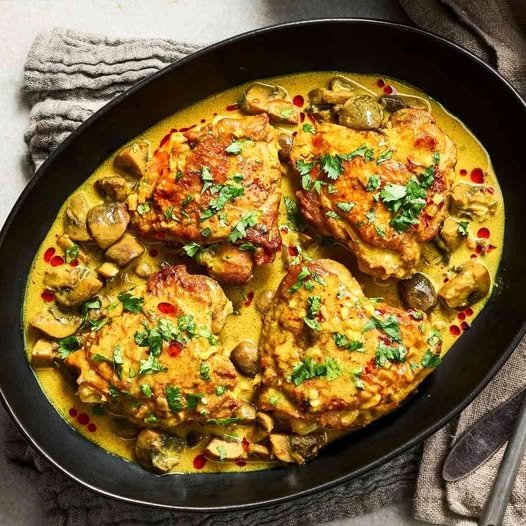Coconut Chicken Curry is a beloved dish for a reason—it’s creamy, fragrant, comforting, and can range from mild to spicy. Here’s a classic, approachable recipe that delivers big on flavor, inspired by Thai cuisine.
This recipe is designed for the home cook and uses a simplified method without sacrificing depth.
Classic Coconut Chicken Curry
This version uses red curry paste for a balanced, aromatic heat and a colorful array of vegetables.
Yields: 4-6 servings
Prep time: 15 minutes
Cook time: 30 minutes
Ingredients
For the Curry:
-
1.5 lbs (700g) boneless, skinless chicken thighs or breasts, cut into 1-inch chunks
-
1 tablespoon neutral oil (like avocado, vegetable, or coconut oil)
-
1 medium yellow onion, thinly sliced
-
1 red bell pepper, sliced into strips
-
3-4 tablespoons Thai red curry paste (like Maesri or Thai Kitchen)
-
1 can (13.5 oz / 400 ml) full-fat coconut milk
-
½ cup chicken broth or water
-
1-2 tablespoons fish sauce (or soy sauce for a vegetarian option)
-
1 tablespoon brown sugar or palm sugar
-
1 tablespoon fresh lime juice
-
Optional Vegetables: 1 cup sliced carrots, broccoli florets, or snow peas.
Aromatics & Garnish:
-
3 cloves garlic, minced
-
1 tablespoon fresh ginger, grated
-
½ cup fresh basil leaves (Thai basil is ideal) or cilantro
-
1-2 red chilies, sliced (for extra heat)
-
Lime wedges, for serving
For Serving:
-
Cooked jasmine rice or basmati rice
Instructions
-
Prepare the Aromatics: Heat the oil in a large skillet or Dutch oven over medium-high heat. Add the sliced onion and bell pepper (and any harder veggies like carrots) and cook for 4-5 minutes until slightly softened. Add the garlic and ginger and cook for another minute until fragrant.
-
Bloom the Curry Paste: Push the vegetables to the side. Add the red curry paste to the center of the pot. Cook it for 1-2 minutes, stirring constantly, until it becomes very fragrant. This “blooming” step deepens the flavor immensely.
-
Cook the Chicken: Add the chicken pieces to the pot and toss to coat them in the curry paste. Cook for 4-5 minutes, until the chicken is mostly opaque on the outside.
-
Simmer in Coconut Milk: Pour in the coconut milk and chicken broth, stirring to combine. Bring the mixture to a gentle simmer, then reduce the heat to medium-low. Let it simmer for about 15-20 minutes, or until the chicken is cooked through and tender.
-
Add Final Flavors & Soft Veggies: Stir in the fish sauce, brown sugar, and lime juice. If you’re using quicker-cooking vegetables like broccoli or snow peas, add them now. Simmer for another 3-5 minutes until the veggies are tender-crisp.
-
Garnish and Serve: Taste and adjust seasoning—add more fish sauce for saltiness, sugar for sweetness, or lime juice for tang. Turn off the heat and stir in most of the fresh basil or cilantro.
-
Serve immediately over fluffy jasmine rice, garnished with the remaining herbs and sliced red chilies, with lime wedges on the side.
Key Tips for the Best Curry
-
Use Full-Fat Coconut Milk: This provides the creamiest, richest texture and flavor. Light coconut milk will result in a thinner, less luxurious sauce.
-
Don’t Skip Blooming the Paste: Cooking the curry paste in oil before adding liquids is a non-negotiable step for unlocking its full potential.
-
Chicken Thighs vs. Breasts: Thighs are more forgiving and will stay juicy and tender during the simmering process. Breast meat can dry out if overcooked.
-
Balance the Flavors: The perfect Thai curry is a balance of Salty (fish sauce), Sweet (sugar), Sour (lime), and Spicy (curry paste). Adjust these elements at the end to your taste.
Popular Variations
-
Green Curry: Substitute red curry paste with green curry paste. It’s typically hotter and has a more herbaceous flavor. Add Thai eggplant for authenticity.
-
Yellow Curry: Use yellow curry paste for a milder, slightly sweeter curry with turmeric and cumin notes. Potatoes are a classic addition.
-
Panang Curry: Use Panang curry paste and add 1-2 tablespoons of crushed peanuts or peanut butter for a nutty, rich flavor.
-
Indian-Style: Use 2 tablespoons of curry powder or garam masala instead of Thai paste. Add tomatoes along with the onions for the base.
Enjoy your journey into making a fantastic homemade curry! It’s a skill that will reward you with countless delicious meals.
